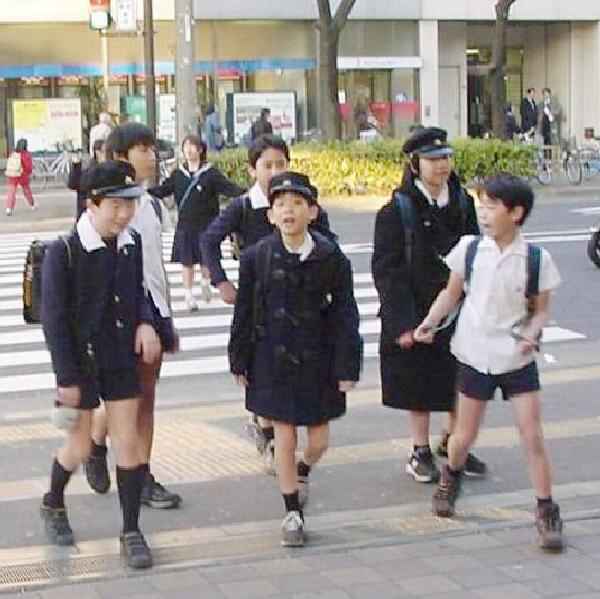
Japanese School Uniform: Seasonal Conventions--Uniform Schools

Figure 1.--These Japanese boys wear the traditinal Prussian-style cadet cap. It is still common at secondary schools, but since World War II not commonly worn at primary school. Note that this scjool is near a seasonal uniform change. Some of the children wear the summer uniform while others are still wearing their coats.
|
Many of the Japanese schools which require uniforms have seasonal requirements. We do not yet have detailed information on the different seasonal adjustments. The approach to seasonality varied at Japanese primary schools. Japan has both primary schools that have uniforms and others that do not have uniforms. While at the non-uniform schools the seasonal clothing changes are left up to the parents discretion. At the uniform schools it is quite differnt.
The most common is to wear jackets during the colder months. Generally the boys wear short pants whether it is winter or summer. The boys might commonly wear kneesocks rather than ankle socks in the winter. Younger boys might wear tights at some schools.Many of these schools have destinct summer and winter uniforms and a time table as to when the shift takes place, a schedule that often does not precisely follow the vageries of actual weather conditions. The schools vary as to how closely they enforce the schedule. Some schools are very strict, others less so. Even in the schools that strictly enfore the uniform regime, often it is left to the parents as to whether the boys wear their overcoats during the winter.
Seasons
Japanese schools had a variety of seasonal uniforms or approaches to seasonal changes.
Generally the boys wear short pants whether it is winter or summer. White shirts are very common at Japanese schools. During the summer boys may wear short sleeved shirts. Ankle socks are also common in the summer. Boys at the many schools that do not require also commonly wear short pants. Boys at the non-uniform schools until the mid-1990s might have worn trim shorts like the boy here (figure 1), but now boys more commonly wear long baggy shorts. Several private schools that have the boys wear blazers or suits during the winter allow the boys to wear just short-sleeved shirts, usulally without toes during the summer. Also ankle socks are often substituted for kneesocks during the summer.
The most common change in the winter is to wear jackets during the colder months. Boys also change tp long sleeved shirts. The boys might also wear kneesocks rather than ankle socks in the winter. Younger boys might wear tights at some schools. One example of a winter school uniform is the uniform worn at Keio. The boys wear navy blue short pants suit with open, white necked collar --vaguely Eton-esque. The school does have uniformed socks--navy ankle socks with a red stripe -- but few boys seem to wear them. Many prefer knee socks in the winter. A few boys wear overcoats, but the vast majority just wore their uniform jackets--presumably with sweaters underneath. Even on brisk, clear, cold days, few boys wear overcoats. Some boys do wear gloves, often the color has to be coordinated with the school uniform.
The approach to seasonality varied at Japanese primary schools. Some schools may no or only minor changes to the basic uniform. The most common is to wear jackets during the colder months. Generally the boys wear short pants whether it is winter or summer. The boys might commonly wear kneesocks rather than ankle socks in the winter. Younger boys might wear tights at some schools.Many of these schools have destinct summer and winter uniforms and a time table as to when the shift takes place, a schedule that often does not precisely follow the vageries of actual weather conditions.
Strictness of Seasonal Rules
The schools vary as to how closely they enforce the schedule. Some schools are very strict, others less so. Even in the schools that strictly enfore the uniform regime, often it is left to the parents as to whether the boys wear their overcoats during the winter.
HBC

Related Chronolgy Pages in the Boys' Historical Web Site
[Late 19th century]
[The 1930s]
[The 1940s]
[The 1930s]
[The 1940s]
[The 1950s]
[The 1960s]
[The 1970s]
[The 1980s]
Navigate the Boys' Historical Clothing School Uniform Pages
[Main Japanese Season School Uniform Page]
[Main Japanese School Uniform Page]
[Australia]
[England]
[France]
[Germany]
[Ireland]
[Italy]
[New Zealand]
[Scotland]
[United States]
Related Style Pages in the Boys' Historical Web Site
[Long pants suits]
[Short pants suits]
[Socks]
[Eton suits]
[Jacket and trousers]
[Blazer]
[School sandals]
Navigate the Boys' Historical Clothing Web Page
[Return to Main school uniform page]
[Introduction]
[Activities]
[Biographies]
[Chronology]
[Clothing styles]
[Countries]
[Bibliographies]
[Contributions]
[FAQs]
[Japanese glossary]
[Satellite sites]
[Tools]
[Boys' Clothing Home]
Created: September 1, 2003
Last updated: May 9, 2004




